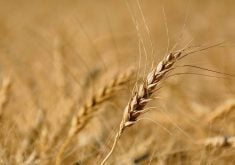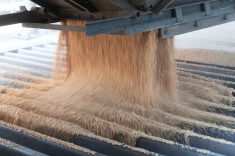The Canadian Grain Commission’s (CGC) Grain Research Laboratory (GRL) is a public good and therefore the Canadian government should fund its work, rather the grain sector.
That’s a recommendation a number of farm and grain industry groups make in their submissions to Agriculture and Agri-Food Canada’s (AAFC) review of the Canada Grain Act and the CGC, which administers it.
Not all submissions refer to the GRL specifically, but those that do say it’s integral to ensuring Canadian grain quality and safety, which is currently part of the CGC’s mandate.
Read Also

Mazergroup’s Bob Mazer dies
Mazergroup’s Bob Mazer, who helped grow his family’s company into a string of farm equipment dealerships and the main dealer for New Holland machinery in Saskatchewan and Manitoba, died July 6 from cancer.
Some of the submissions that don’t name the GRL imply support for it, saying the CGC should continue to ensure Canadian grain quality control.
Why it matters: The Canada Grain Act review is expected to bring changes to the Canadian Grain Commission and its Grain Research Laboratory, which underpins the commission’s efforts to ensure Canada’s grain quality-control system.
The grain act requires the CGC to be self-funding, which it currently does by charging fees for its services, many of which, including outward grain inspection for Canadian grain exported by ship, are mandatory.
Several submissions, including from the Saskatchewan Wheat Development Commission (Sask Wheat), note some of Canada’s major grain competitors, such as the United States, charge user fees that reflect their direct costs.
“The overhead associated with maintaining the U.S. quality assurance system is covered by the U.S. government,” Sask Wheat’s submission says. “The USGSA (U.S. General Services Administration) is very specific in its language that (U.S) FGIS (Federal Grain Inspection Service ) fees will only be for the actual cost of providing the inspecting service with the government picking up the public good aspects of the quality assurance and overhead of the inspection system.

As a result U.S. grain inspection fees are lower than the CGC’s at around 80 cents a tonne in the U.S. versus $1.34 in Canada.
“Although the majority of the work completed by the GRL is considered a public good, currently grain research is funded by approximately 50 per cent appropriation and 50 per cent service fees,” Sask Wheat says. “Sask Wheat strongly encourages the federal government to review the appropriation funding levels for the CGC and GRL to ensure they accurately reflect the benefit to the public.”
The Agricultural Producers Association of Saskatchewan (APAS) makes the same point.
“The federal apportionment of between $5 and $6 million annually only represents about nine per cent of the CGC operational budget,” APAS’s submission says. “By comparison, 33 per cent of the US Federal Grain Inspection Services budget is funded by government sources.
“APAS requests increased federal funding for CGC programs to fully support public good services that benefit all Canadian and to reduce the reliance on user-fees to cover operational costs.”
Cereals Canada’s submission notes that U.S. and Australia’s grain inspection agencies don’t operate on full cost-recovery.”

In a joint submission the Alberta wheat and barley commissions call for the GRL and other CGC services considered a public good to be paid for by taxpayers.
The Western Grain Elevator Association, which represents Canada’s biggest grain companies, says the same in its brief.
The GRL plays an important role in maintaining Canada’s grain quality “brand,” Sask Wheat’s submission says.
“The quality and safety assessment work that the GRL does has become even more important in recent years in resolving market access issues that the Canadian grain industry has faced,” the submission says. “As protectionism and non-tariff trade barriers continue to rise in international markets, the work the GRL does will continue to be of utmost importance to the grain industry. Therefore, it is crucial to ensure the GRL has adequate funding and infrastructure moving forward.”
Even though Canadian wheat now sells at a discount to like-quality American wheat, ensuring Canadian buyers get good quality is crucial, Sask Wheat says.
“Customer confidence in the quality assurance system as well as the intrinsic quality of Canadian grain is very important to Canada’s brand in world markets,” its submission says. “The commercial environment is driven by multiple factors but ultimately all buyers make decisions based on value. Reliability, predictability, quality, safety and regulatory compliance are key ingredients in the customer’s determination of value.
“If there is a deterioration in these attributes, it will impact the market value of Canadian grain and oilseeds relative to what is earned by our competitors..”

The CGC and its GRL have played a vital role in protecting not only the end-use quality of Canadian grain, but also its safety, the Canadian National Millers Association (CNMA) says in its submission.
“(T)he commission’s core competencies in these activities, collaborative research, laboratory analytical capacity, post-market surveillance of end-use performance and consultations are the underpinning of wheat quality and end-use performance from a milling industry perspective,” CNMA’s submission says.
If not for the GRL’s long-term research coupled with the findings of milling and grain industry-led research, Canada would lack sufficient information to set safe limits for mycotoxin in cereals and grain-based foods.
“We wish to emphasize that the commission’s scientific understanding, research capacity and knowledge were of pivotal importance in preventing the unwarranted adoption of new regulatory constraints in the form of maximum limits for (the naturally occurring mycotoxins) DON (deoxynivalenol) and OTA (Ochratoxin A) in unprocessed grains, milled grain products and grain-based foods,” the submission says. “The proposed MLs (maximum limits) and related analytical laboratory costs of compliance monitoring would have added significant cost burden with accompanying improvement in food safety.”
The CGC was established by the federal government in 1912 following years of complaints from Western farmers of unfair treatment by grain buyers. The Canada Grain Acts states that “…the Commission shall, in the interests of the grain producers, establish and maintain standards of quality for Canadian grain and regulate grain handling in Canada, to ensure a dependable commodity for domestic and export markets.”
The Harper government wanted to revise the grain act in 2014, but the legislation was derailed by the election 2015.
In 2019 the current federal government started over, but the process was waylaid by the COVID-19 pandemic in early 2020
AAFC consulted with the grain sector from Jan. 12 to April 30.
AAFC is assessing submissions now. A summary will be published in the coming weeks.
“The next steps following the summary report will be informed by the results of the consultations and are yet to be determined,” an AAFC official wrote in an email May 5.



















